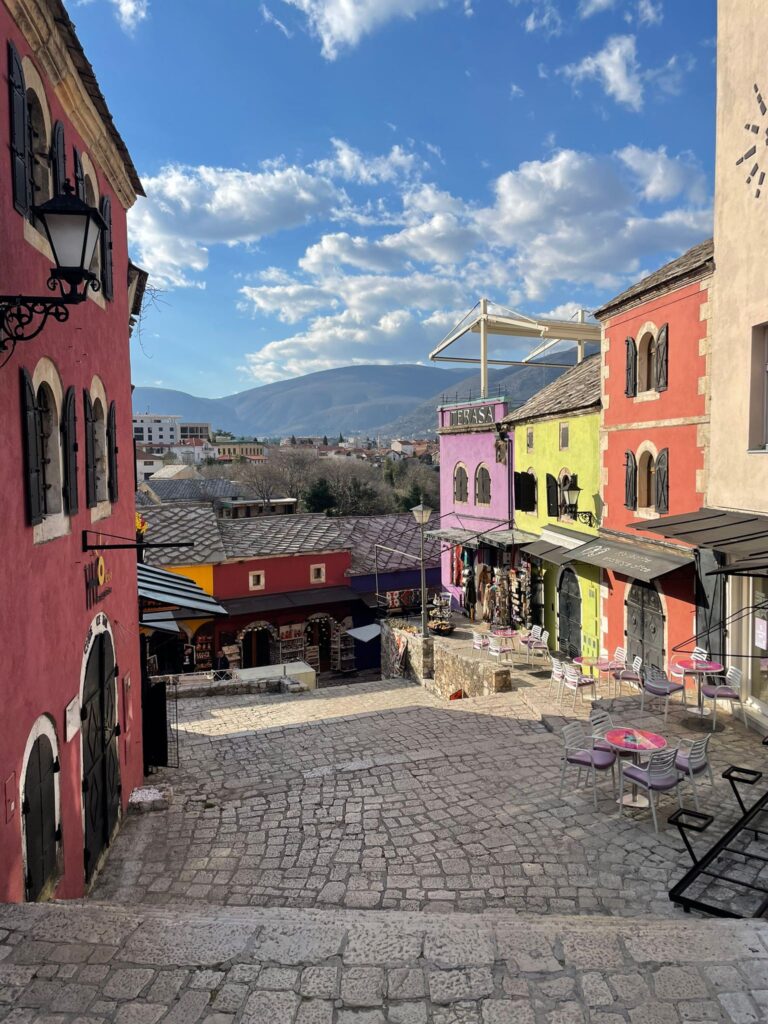Is Bosnia Herzegovina Europe’s Best Kept Secret?
Disclaimer: Some links on this page may be affiliate links. If you purchase anything through them, I will receive a small commission at no extra cost to you! Further details in the Privacy Policy.
Introduction
Bosnia Herzegovina is a country mostly known for negative reasons. War and genocide ravaged the country in the 1990s, leaving deep scars which remain vividly today. However, the country has started to attract more and more tourists in recent years. Where are the best places to visit in Bosnia? I will talk about that and more in this trip report on what quickly became one of my favourite countries in Europe.
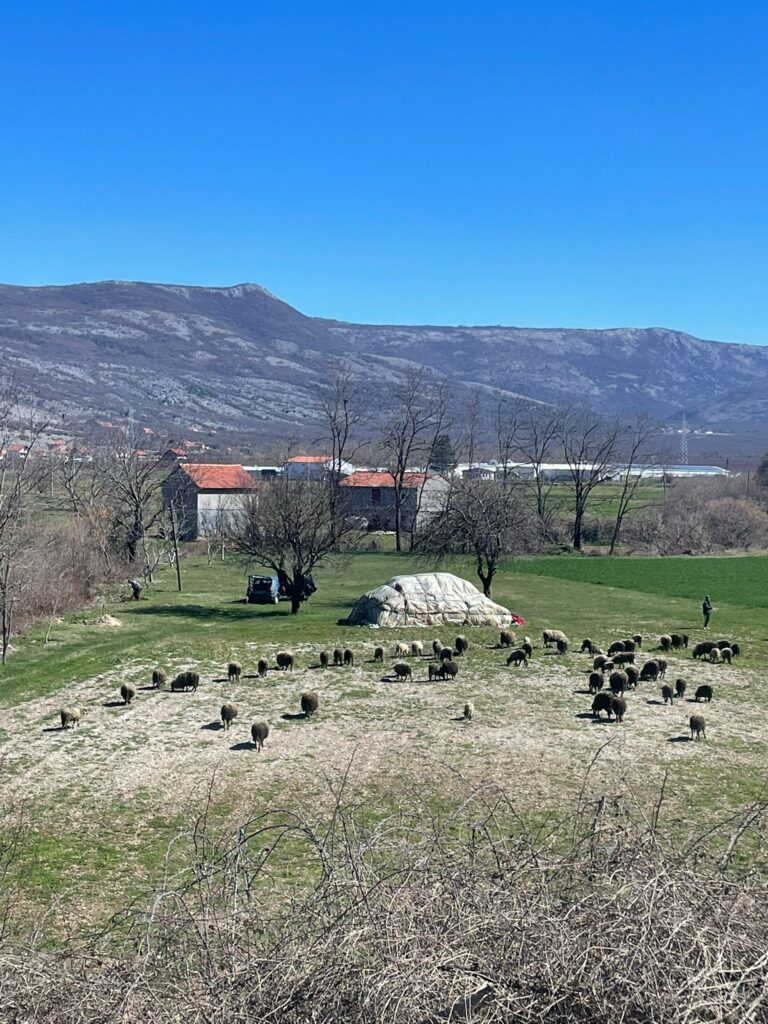
Background on Bosnia Herzegovina
The Dark Days of War and Genocide
The country was a part of Yugoslavia alongside modern-day Croatia, Slovenia, Serbia, Montenegro, Kosovo and North Macedonia. However, the socialist republic broke up during the collapse of communism in the early 1990s. Whilst Slovenia and North Macedonia gained independence with minimal violence, that was not the case amongst the rest of the region.
Since the death of Tito a decade previously, tensions had soared between three different ethnic groups which were amongst the most prominent in Yugoslavia: Croats, Serbs and Bosniaks. The three had different ideas on how borders should be drawn in a post-Yugoslavia world. The Serbs in particular were not happy with the borders of Bosnia Herzegovina. This is because a lot of Serbs lived in parts of the country, which they claimed should be part of Serbia.
From 1992-1995 the country was a deadly warzone where the three ethnic groups fought. Things were further complicated by the introduction of self-declared breakaway “states” including the Croatian Republic of Herzeg-Bosnia and Republika Srpska which sought to tear Bosnia apart. War descended into genocide with over 8,000 killed in less than a month in the small town of Srbrenica.
The war eventually ended, but left a lasting impact. Millions of deadly landmines were left across the country. There have been deaths in each year until at least 2019 as a result. Also, almost no Bosnian over 30 remains unaffected by the events of the 1990s. Almost everyone who lived through this decade knows someone who was injured or killed in the war.

Modern Day Bosnia Herzegovina
Despite the lingering mental scars of 1992-1995, Bosnia Herzegovina is a country with a lot of charm, beautiful scenery and friendly people today.
Politically, power is shared between three “presidents” – one from each of the three major ethnic groups: Bosniaks, Croats and Serbs. Whilst this political system was designed to keep the peace, which has just about held up since the turn of the century, it has slowed the country’s progress.
The three ethnic groups all have differing interests, and it’s rare for all three leaders to agree on the same path forward. Therefore, Bosnia struggles to move forward with constant political deadlocks. It is a country with high levels of poverty, corruption and unemployment. Almost half of youngsters now plan to leave Bosnia Herzegovina for better opportunities abroad.
On the Plus Side
The past may be bleak, and the future pessimistic under the current circumstances. But there is also a lot of good in Bosnia Herzegovina. It has retained a lot of charm from its days as part of the Ottoman Empire. Ottoman mosques and markets remain in the likes of Mostar and Sarajevo.
Speaking of Mostar, it has undergone a major renovation since 75% of the city was destroyed in the war. Today it is one of the most beautiful cities in Europe, with stunning lake and mountain scenery. More on Mostar later. Is is certainly one of the best places to visit in Bosnia Herzegovina.
The people are resilient and incredibly welcoming. A Bosnian will treat a guest like royalty. Many are very grateful to see you giving their country a chance after what they have been through.
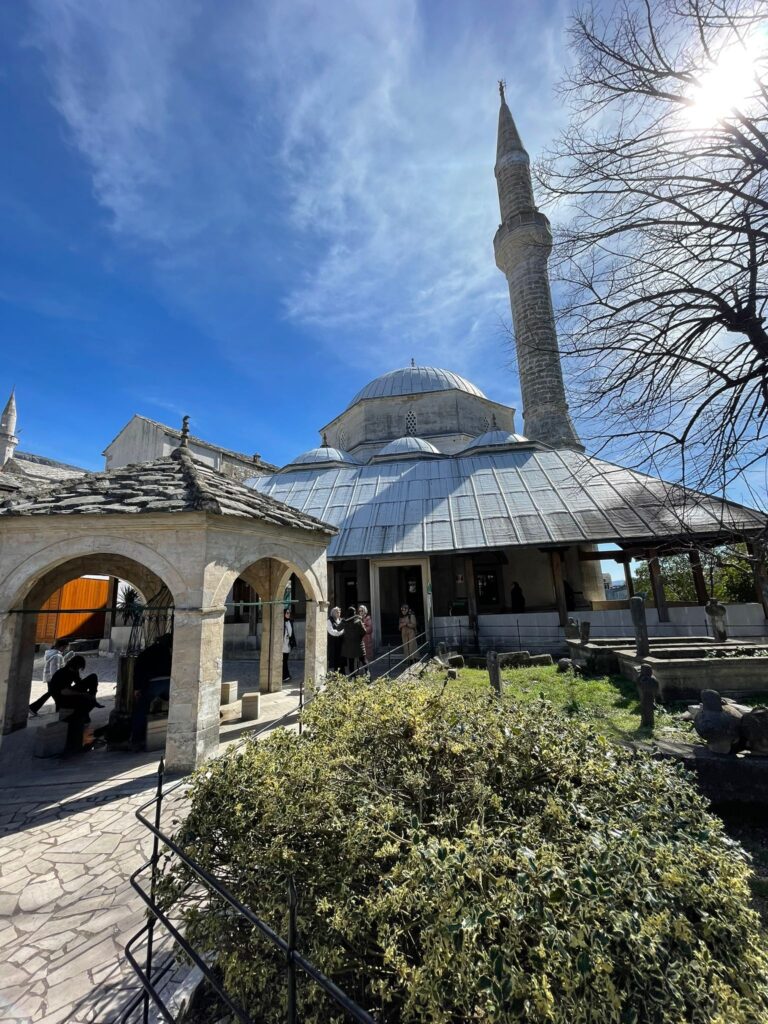
Is Bosnia Herzegovina Safe?
The country has moved on from the dark days, at least in terms of danger to visitors. Is Bosnia safe? Absolutely.
Crime is very low, typical for a Balkan country. Unfortunately low is not zero, and pickpockets do operate in Mostar and Sarajevo. In fact I did a walking tour in Mostar, and our guide recognised some local ladies as pickpockets.
Roads can be hazardous. Bosnian drivers do have a tendency to go faster than they should in rural areas, and have been known to drive aggresively.
The big hazard in Bosnia is landmines. As mentioned previously, millions were placed during the war. Whilst NGOs and the government have worked endlessly to remove these, there are still many out there. The good news is that you can easily avoid them with some basic safety precautions. Bosnia Herzegovina is one country where it is not wise to go off the beaten path. Mines are often hidden in remote areas. Warning signs are abundant, but do not cover all mine zones.
The simplest advice is to stay in populated areas and not step off the roads whilst travelling between cities. Follow this advice and you will not have to worry about landmines. In fact they won’t be a problem at all if you stay in the touristy areas. So please don’t be dissuaded from seeing this incredible countries because of landmines.

How to Visit Bosnia Herzegovina
How to Get to Bosnia Herzegovina
You don’t need a visa to visit Bosnia Herzegovina if coming from most of Europe (excluding Belarus) or the mainland Americas (excluding Ecuador, Bolivia, Guyana and Suriname). Australia, New Zealand, Japan, South Korea, China, Malaysia and a number of small island countries and Gulf states also have visa-free access to the country.
Sarajevo is the most popular airport in Bosnia Herzegovina. The most common flights to the capital come from Vienna and Zagreb. Aside from those two, Istanbul and Belgrade are the only other cities averaging at least one flight per day to the country. Frankfurt, Jeddah, Dubai, Skopje and Zurich all operate at least ten flights a month to Bosnia. The UK, Qatar, Egypt, Norway, Sweden and Poland also have routes to Sarajevo, albeit less frequently.
There are four international airports in Bosnia Herzegovina. The others are in Mostar, Tuzla and Banja Luka.
Croatia is the only country with trains to Bosnia Herzegovina. Whilst buses run regularly from Croatia, Slovenia, Montenegro and Serbia.
Getting Around in Bosnia Herzegovina
Buses are the best way to get around in Bosnia Herzegovina. They connect all of the major destinations. Although can be a lot rarer when crossing into different ethnic territories. For example, it is tricky to get from Sarajevo to Srbrenica as there are few transport options heading into Republika Srpska, the Serbian-dominated part of Bosnia.
Trains exist between the major destinations. Namely Sarajevo, Mostar, Tuzla and Banja Luka.
Driving is not recommended, mostly due to the landmine situation. If you only drive on common roads however then you will not have any issues.
Is Bosnia Herzegovina Expensive to Visit?
Not particularly. Accommodation and transport are very affordable, making Bosnia Herzegovina a very cheap country to travel in. Food is also on the cheap side with local favourites such as cevapi certainly on the budget-friendly side.
The one drawback is that Bosnia Herzegovina is a cash-only country in most places. You will find very few places here which take card. And ATM fees for withdrawing cash are high. All ATMs (outside of ATOS Bank, only found in Republika Srpska) charge from 7-15 Bosnian marks just to withdraw money. That’s £3-7 or $4-8 just for a single cash withdrawal, on top of what your own bank may charge.
Best Places to Visit in Bosnia Herzegovina
What are the best places to visit in Bosnia Herzegovina? I went to the two most popular and was not disappointed. Mostar and Sarajevo are both absolutely fantastic places to see. Here I will give some suggestions on what you can do in both.
Mostar
When talking about hidden gems in Europe, Mostar should be right at the top of the list. Although not for much longer, because people are beginning to find out about this stunning city, so be sure to enjoy it before it becomes too crowded.
Without further ado, let’s get stuck into how you can enjoy your time in Mostar.

Do a Free Walking Tour
What is a Free Walking Tour?
This is a tip I would recommend for any new city you visit, particularly in a country you have not previously visited. A “free” walking tour is actually paid for by tips. You can choose how much you pay the guide, although £5-10 is generally the accepted average per person, depending on the country. It is rude to not pay the guide so this should only be done if the tour is truly terrible.
A free walking tour works by meeting a guide at a pre-arranged time and place. The guide will then show you around the city for 1-3 hours (around 1.5-2 hours is the length of the average tour). Here they will show you the interesting places, tell you all about the history of the city/country and more. Some tours will take you around local markets and give you free samples of local foods and drinks. In one case, we were taken to feed llamas on a free walking tour. This particular one took place in Arequipa, Peru.
Where to Find a Free Walking Tour
Free walking tours are often advertised in popular hostels. However they can also be found online. Google “free walking tour Sarajevo” (changing Sarajevo for the name of the city you are currently in of course). Options will vary depending on the city and country. More touristy spots will have several different tours available. Many will be general tours, however some focus on a specific aspect such as art, graffiti, history or food.
Having done around 30 free walking tours, they are generally easiest to find in Europe and Latin America. The Middle East had few options available, and I was only able to do a tour of Amman in Jordan.
My favourite website for finding free walking tours is GuruWalk. They offer tours all over Europe and the Americas as well as large chunks of Asia and even a few spots in Africa. Click on the link above to see exactly where they operate.
Tour group sizes vary depending on the destination, time of year you visit, weather and more. Some tour groups have had up to 30 people. Whereas in La Paz (Bolivia) and Cusco (Peru) I was the only person on the tour.
If you want to know the best places to visit in Bosnia Herzegovina, do a walking tour!
Mostar Free Walking Tour
Speaking of the best places to visit in Bosnia Herzegovina, let’s get back to talking about Mostar and the free tour here.
The tour starts on the east side of the river, which is where most people will arrive in Mostar by bus or train. The river divides ethnic groups with one side dominated by Bosniaks, and the other by Croats. The majority of Serbs left long ago, in many cases not through choice. Our guide informed us that tensions remain so high, many Bosniaks and Croats living just minutes from the river have never crossed to the other side.
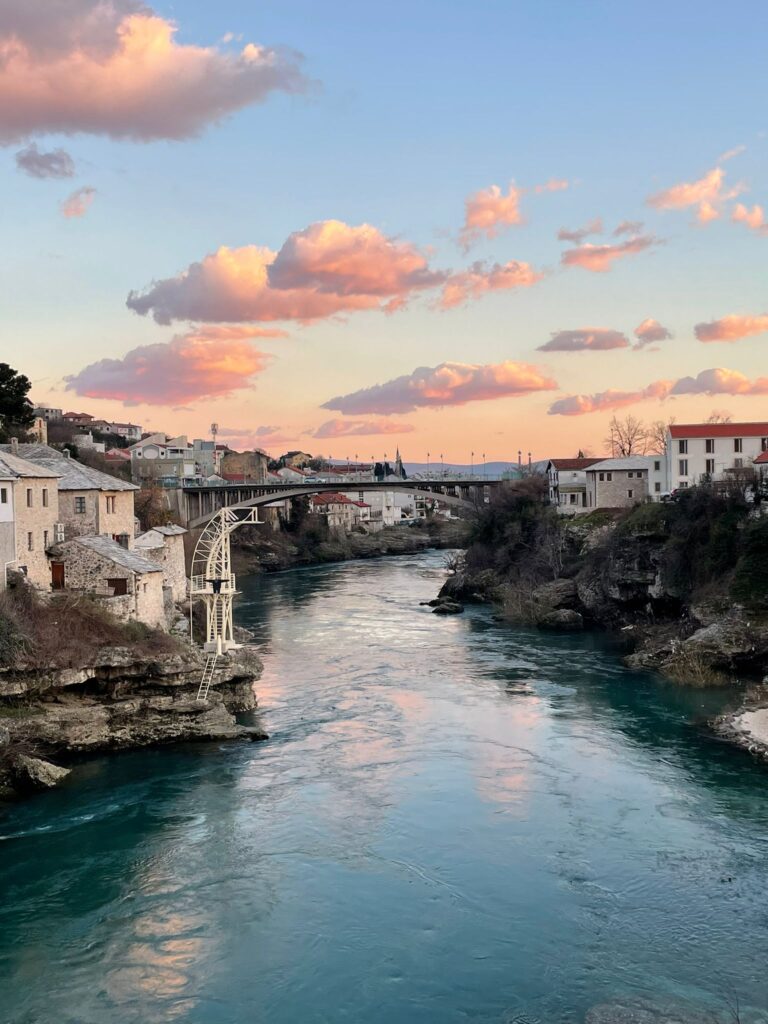
Walking further along and we were taken to a graveyard. The guide said burials took place at night time with it being far too dangerous to go outside during daylight.

Across the bridge to the west side of the river we saw run-down socialist-style buildings riddled with bullet holes. A road in front of these buildings was so dangerous that the life expectancy here during the war was two seconds. Anyone attempting to cross would be greeted by mortar fire.
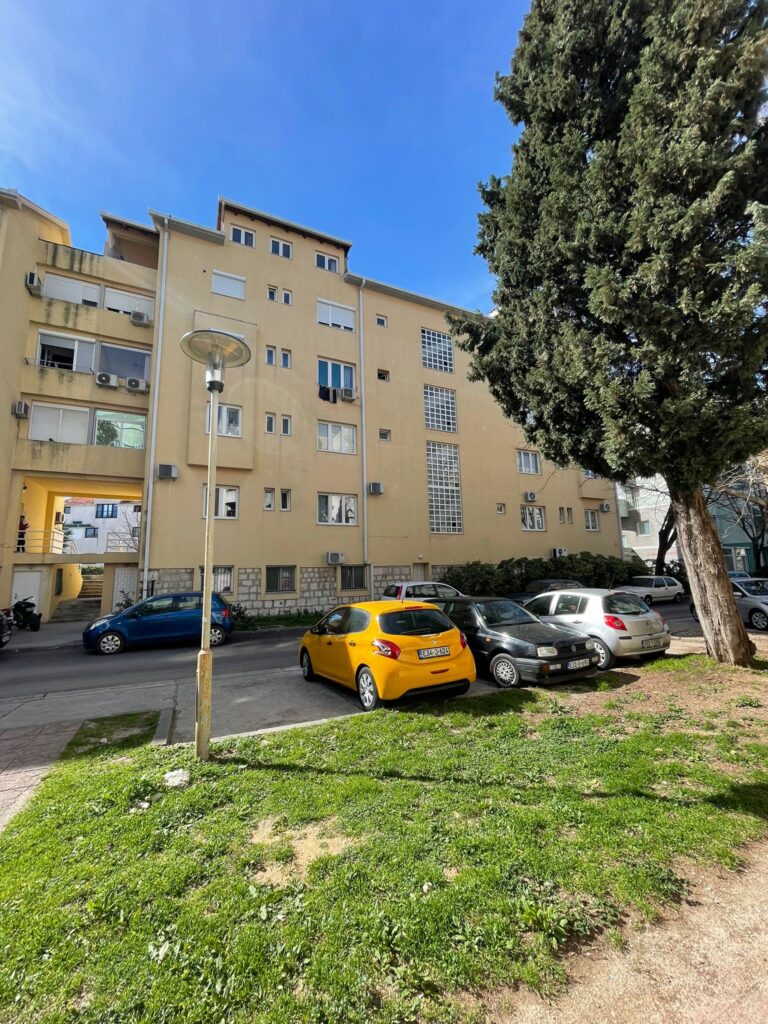
The tour also took us around the Ottoman mosques and bazaar on the Bosniak side. Bosniaks are predominantly Muslim. Although just like in nearby Albania, they practice a very liberal form of Islam. Pork is common on the menus here and beer is widespread. The only time you will need to adhere to the sorts of rules more common in a more religious country such as Saudi Arabia, is if you enter a mosque.
I highly recommend the free walking tour in Mostar if you come to this wonderful city.
Stari Most
Stari Most is the most famous bridge in Mostar. This scenic arch is not just well known for looking pretty however. It is also well known for being a diving spot where locals jump off the bridge into the Neretva River below.
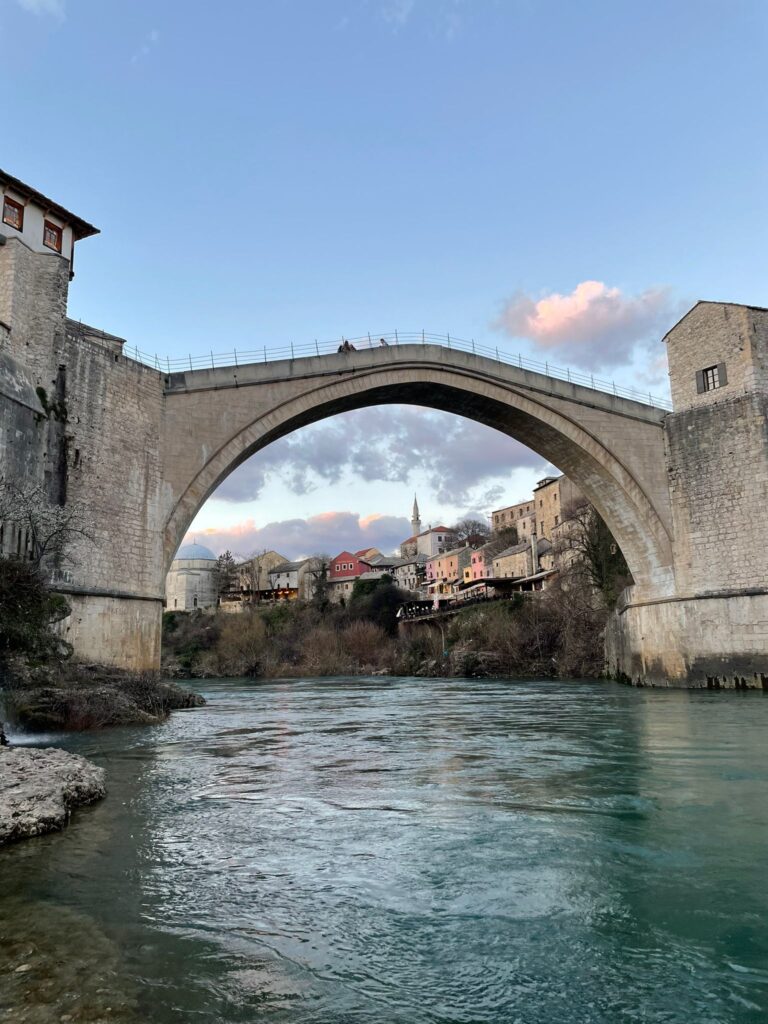
Diving off Stari Most has become a tradition in Mostar dating back to 1664, with annual diving competitions being held there for the last half-century.
Tourists can even dive off the bridge, however you will need to visit the Mostari Diving Club first. From here, you will need to pay, and the diving club will take you through a practice jump before determining whether or not you are ready for the real thing. It costs ten euros for the practice jump and a further twenty for the main jump.
If you jump then you will receive a certificate and join an exclusive group of under 1,000 people who have also achieved this feat.
Be warned however, there have been multiple deaths and injuries from people diving off the bridge. Do not attempt this unless you know exactly what you’re doing.
Food and Drink in Mostar
Surrounding Stari Most are a range of local food and drink spots where you can get stuck into a good Bosnian beer, try some of the local rakija, and sample some traditional Balkan cuisine.
Mostarsko Pivo is the beer of choice in the local area. With a 5% volume it won’t take many of these to get you feeling nice and relaxed.
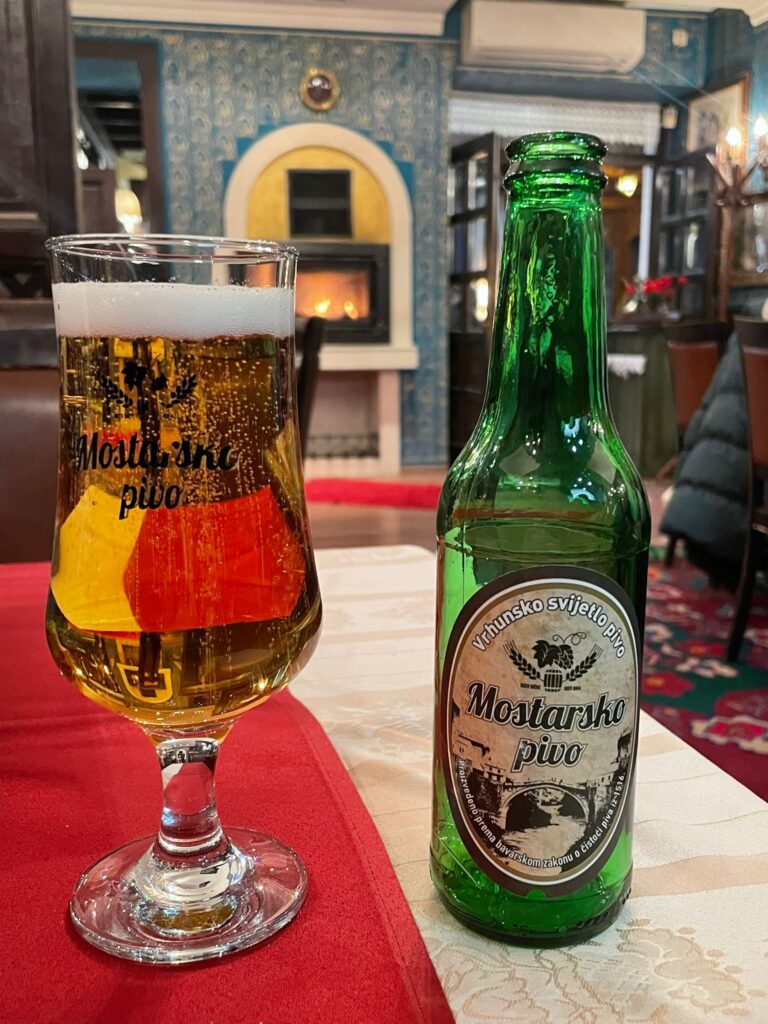
If you fancy something a little stronger, the popular Balkan spirit rakija is easy to find. This fruit brandy is sold just about everywhere in Bosnia, and can often be brewed at home by locals. It’s normally around 40% in volume, however home-brewed versions can be up to double that.
Food in Mostar is a case of the Balkans meets Turkey. Heavy meat dishes such as cevapi and pljeskavica are popular here. Whilst Balkan favourite ajvar, a pepper-based sauce is also commonly found. Serbian pastry burak is also a Mostar favourite, a pastry filled with meat and potato.
For desserts, popular Turkish option baklava, made of chopped nuts, syrup and pastry is found all over Mostar. Ice cream is also common as are sutlijas (rice pudding) and orasnica (walnuts mixed with egg whites). The latter two being some of Bosnia’s finest desserts.
Mostar is certainly one of the best places to visit in Bosnia Herzegovina. But not the only one worth visiting.
Sarajevo
We cannot talk about the best places to visit in Bosnia without mentioning the capital. Sarajevo has a lot of charm, a fascinating history, and a great blend of new and old. Don’t come to Bosnia without checking out the capital.

Sarajevo Free Walking Tour
The walking tour in Sarajevo is just as worthwhile as the one in Mostar. This one takes you to some historical spots as well as showing you the traditional culture.
Sarajevo’s Ancient Traditions
There are signs in the older Ottoman-style part of Sarajevo of traditions being kept alive. But these traditions are fading fast. One carpet maker creates Iranian-style carpets and sells them. However, the carpets take months to make and Bosnians often don’t have the money to spend on such luxuries. On top of this, with so many youngsters leaving for a better life abroad, few people are left with both the skills and desire to continue this tradition. Which means it may not be around in Bosnia for much longer.

Similarly, the tour took us to a coppersmith’s store. He worked crafting bookmarks out of metal, which he sold alongside other handcrafted items. For the same reasons, this tradition is becoming less popular and may not be around in the country forever.
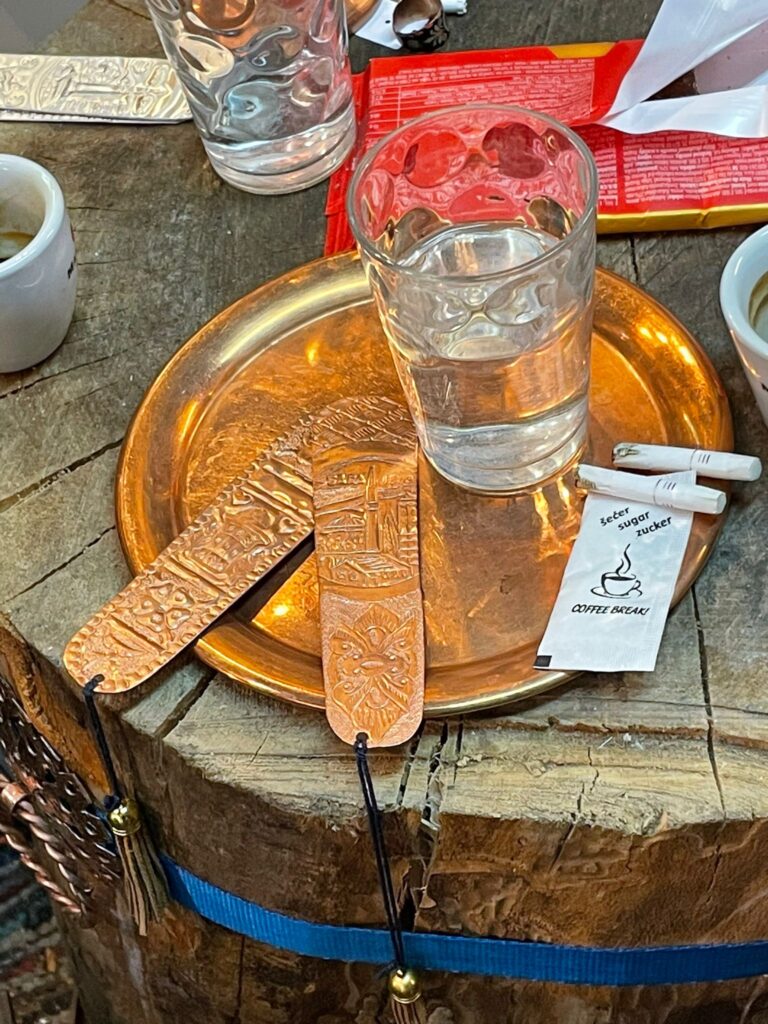
Remnants of War
The tour then progresses through several parts of Sarajevo where mortar damage and bullet holes remain today. On the ground are several red marks – the Sarajevo roses. These are mortar-damaged holes in the ground which have been painted red to resemble bloodstains. They exist to remind people of what happened during the 1990s in Bosnia Herzegovina.
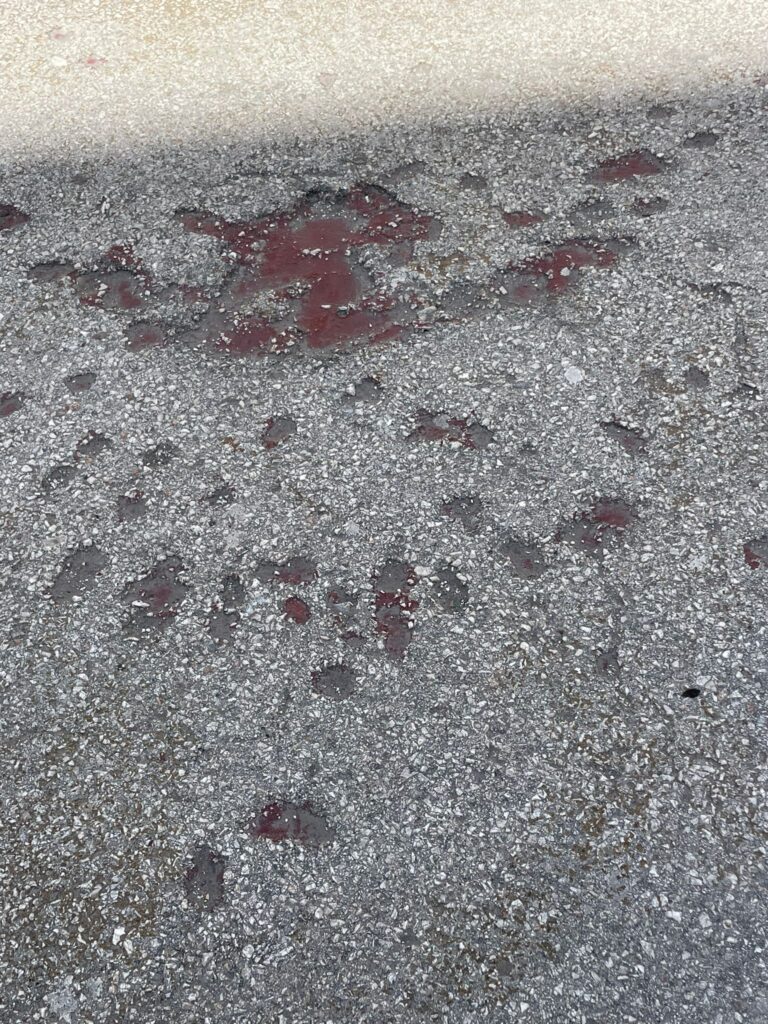
Sarajevo was also the starting point for a much bigger conflict: World War I. In June 1914, Bosnian-Serb Gavrilo Princip murdered Austrian Archduke Franz Ferdinand and his wife Sofia. This quickly escalated into a conflict which claimed over 17 million lives. A plaque has been erected at the very spot where Princip fired his deadly shots. The tour will take you here and explain exactly what happened.
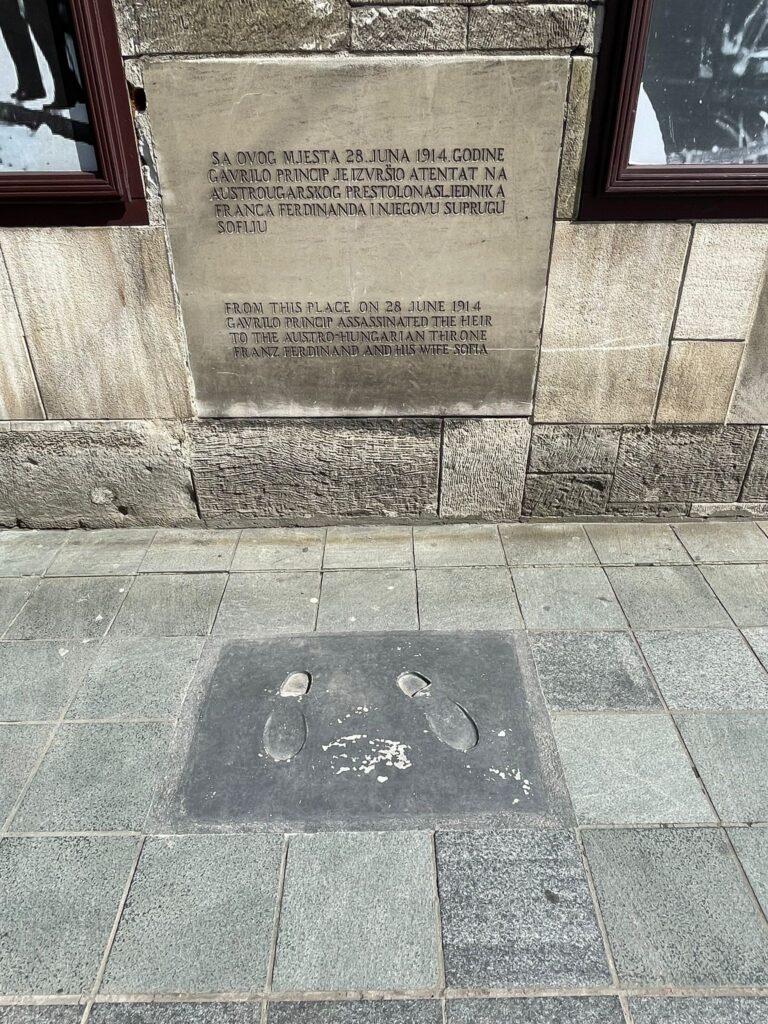
One of the last stops on the tour is the Meeting of Cultures. This line separates Sarajevo in two. On one side you can see the traditional Ottoman part of the city. Turn around 180 degrees and you will see a modern shopping area that could look like any major Western European city in the 2000s.
The 1984 Winter Olympics in Sarajevo
As part of Yugoslavia, Sarajevo was one of the host cities for the Winter Olympics in 1984. You can still see remnants of the games left behind today. A short hike in the capital will take you up towards the bobsled track which was used. Today it is a large decaying concrete structure covered in graffiti. It is no longer functioning but is fun to see. Plus there are some great views of Sarajevo from near the track.
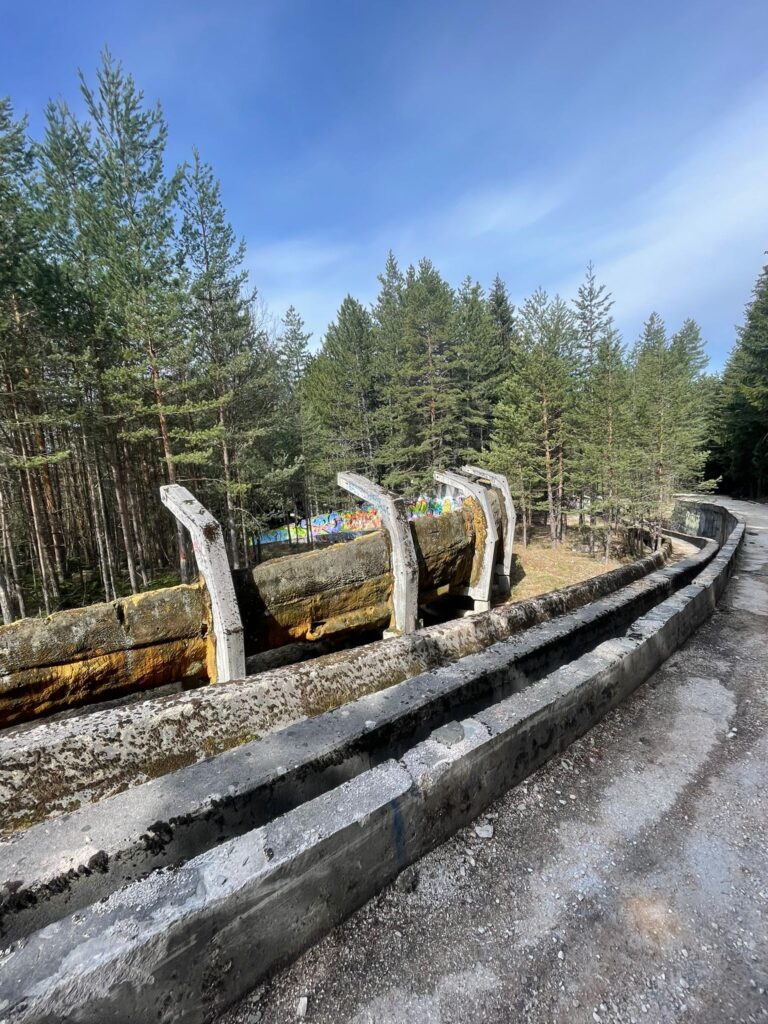
On the way up you can walk past a graveyard with almost all of the death dates being in 1996. This was the year that the four-year Sarajevo Siege came to an end as part of the Bosnian war.

You can also see the remains of bombed out houses. Just a little further from the bobsled track is the “border” separating Bosnian-controlled territory from the Republika Srpska.
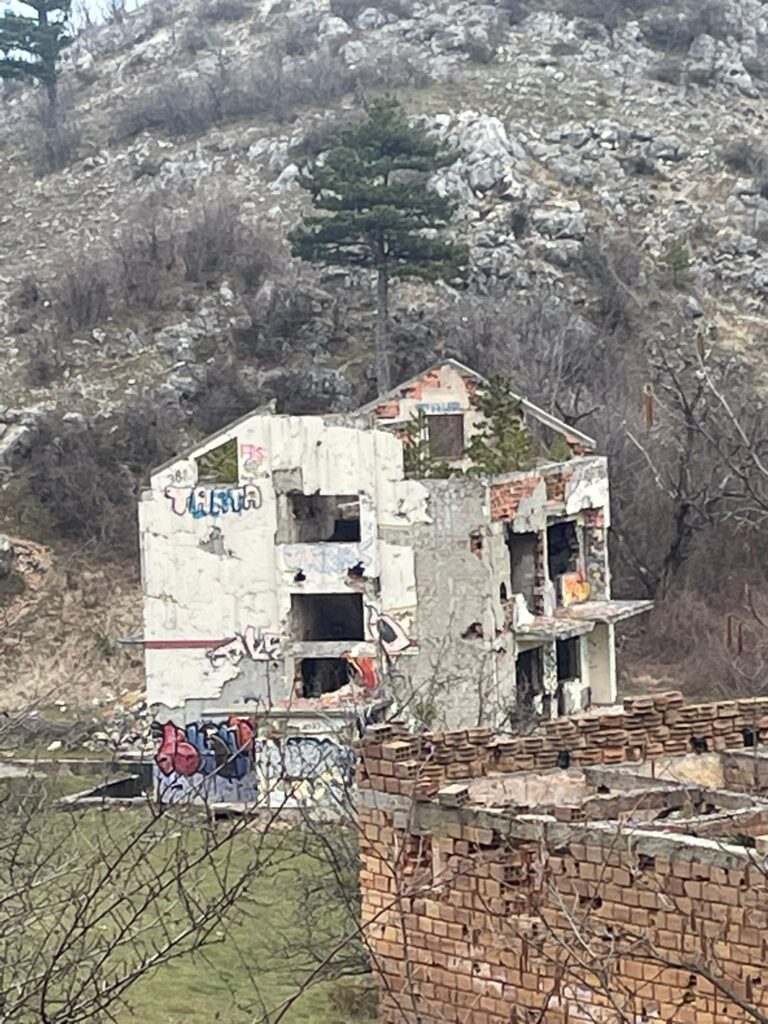
Where to Stay in Bosnia Herzegovina
As always I will only talk about places I’ve actually stayed in. As someone who generally stays in hostels, I did the same here. Therefore if you are looking for recommendations on hostels in Mostar and Sarajevo, read on. But otherwise, skip this section.
Mostar: Hostel Taso’s House (£9/$11 Per Night) (Closed October-March)
Please note Taso’s only opens between March and October which is when the majority of tourists come to Mostar.
Pros
This excellent property has a 9.4 rating on Booking, and you can see why. Taso is very friendly and accommodating. His house includes a breakfast which you can choose the night before. The lockers are a large size, the showers were lovely and warm. The wifi also worked perfectly. The location is very close to Stari Most and other attractive parts of Mostar.
Cons
The room was a little chilly at night time.
Overall
A fantastic place to stay. Would highly recommend Taso’s to anyone. Absolutely deserving of the high rating, and one of the best places to stay in Bosnia.
Sarajevo: The Good Place Hostel (£10/$12 Per Night)
Hosted by local man Igor, this hostel has three dorm rooms and a small social area, as well as a corridor with seats to socialise or work from.
Pros
Igor is very friendly and offered rakija on arrival. He really makes an effort to get to know his guests. The rooms were quiet, wifi worked well, lockers were large and showers were warm here. The location is very central as well.
Cons
There was only one small toilet for each gender in the hostel. Can be a bit of an issue if it’s busy.
Overall
Sarajevo is one of the best places to visit in Bosnia Herzegovina and The Good Place Hostel is certainly a good place to stay. One of the better hostels I’ve stayed in from 150+ around the world. Probably in my top ten worldwide.
Final Thoughts on Visiting Bosnia Herzegovina
Is Bosnia Herzegovina worth visiting? Absolutely. It is one of the best countries in Europe by far.
If you have an interest in history, exploring beautiful places, meeting friendly locals, eating great food and doing all of this on a low budget, then it is absolutely worth visiting Bosnia Herzegovina.
This is one of the biggest hidden gems in Europe, but it won’t be for much longer. So hurry up and visit Bosnia before it becomes swamped with tourists.
Sarajevo and Mostar are some of the best places to visit in Bosnia Herzegovina, but given more time there are other stops I would have liked to visit. Una National Park on the Croatian border looks stunning, whilst Banja Luka is also said to have some great scenery. Srbrenica is a little harder to get to, but you may wish to visit and understand the full extent of the tragedies which occurred there. These places are certainly on the hitlist for my next trip to Bosnia. Because there will definitely be another trip.
I would strongly urge you to consider a holiday in Bosnia Herzegovina as your next adventure. You won’t regret it.
If you enjoyed reading this, please check out my destinations page with stories from everywhere on my quest to visit every country in the world.
